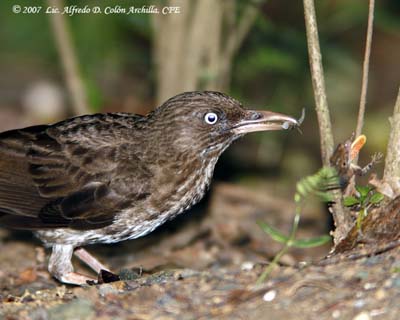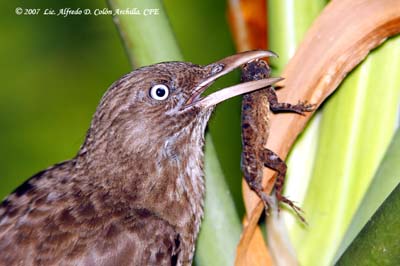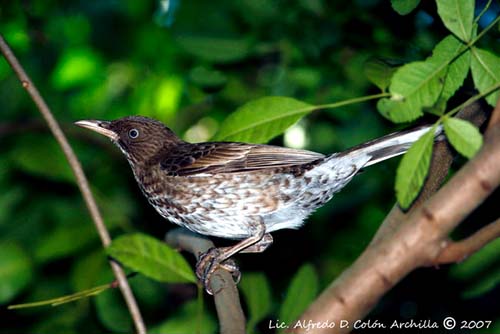
Pearly-eyed Thrasher
Margarops fuscatus
Passeriforme Order – Mimidae Family
BIOMETRICS :
Length: 28-30 cm
Weight: 75-140 g
DESCRIPTION:
Pearly-eyed Thrasher is a common species. This bird is known in Puerto Rico to compete with the Puerto Rican Parrot for nesting cavities and predation of the eggs of this critically endangered species. This bird is the largest of the Mimidae.
PROTECTION / THREATS / STATUS:
Pearly-eyed Thrasher is common in most parts of the range. It is an adaptable and opportunistic species, often considered as an important threat for rare birds’ species such as the Puerto Rican Parrot in Puerto Rico. This bird is also considered as a pest of crop fruits.
Fr: Moqueur corossol
All : Perlaugen-Spottdrossel
Puerto Rico : Zorzal pardo
Esp: Azotador de Ojos Perlados
Ital: Mimo occhidiperla
Nd: Witoogspotlijster
Russe: Пересмешниковый дрозд
Photographs by Alfredo Colón
Puerto Rico Wildlife
Text by Nicole Bouglouan
Sources :
HANDBOOK OF THE BIRDS OF THE WORLD Vol 10 by Josep del Hoyo-Andrew Elliott-David Christie - Lynx Edicions - ISBN: 8487334725
WRENS, DIPPERS AND THRASHERS by Brewer David – illustrated by Barry Kent Mackay- Yale University Press - ISBN: 0300090595
Wikipedia (Wikipedia, The Free Encyclopedia)

Adult male has brown upperparts and crown, with streaked effect due to darker feather centres. Wings and tail are darker, blackish-brown. Secondary outer webs are edged rufous, and tertials are tipped white.
Uppertail coverts show white centre and tips. Outer rectrices are broadly white-tipped.
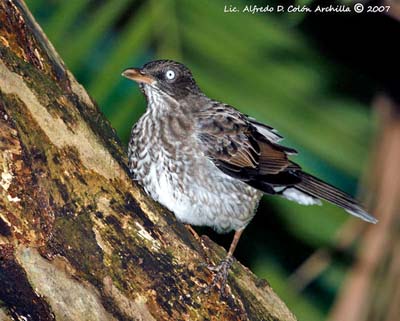
Underparts, including chin and throat, are whitish streaked brownish. White belly shows only indistinct markings.
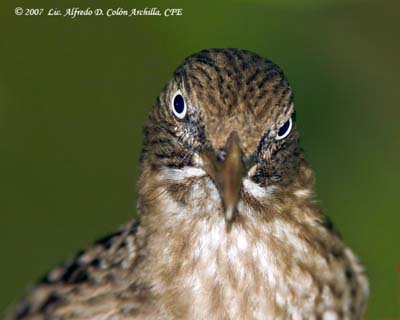
On the head, crown is brown streaked darker brown. Head sides and face are mottled darker.
Bill is robust and horn-coloured. Eyes are pale grey-white, similar to pearls. Legs and feet are pale brown to grey.
Both sexes are similar in plumage, but female is slightly larger and heavier than male.
Juvenile resembles adults.
We can find some subspecies:
M.f. fuscatus: Eastern Bahamas and Puerto Rico to St Lucia.
M.f. densirostris: Lesser Antilles. This one is larger, darker and more streaked than nominate.
M.f. klinikowskii: St Lucia, in SC Lesser Antilles. It is the largest race and shows more contrasts in plumage.
M.f. Bonairensis: Bonaire Island (Netherland Antilles). It has more greyish-olive plumage than brownish.
VOICE: SOUNDS BY XENO-CANTO
Pearly-eyed Thrasher often sings by day and during the clear nights from elevated perches. Song is a series of slow whistled phrases with lengthy pauses between each phrase.
It also utters raucous call with guttural “craw-craw”, and harsh “chook-chook”.
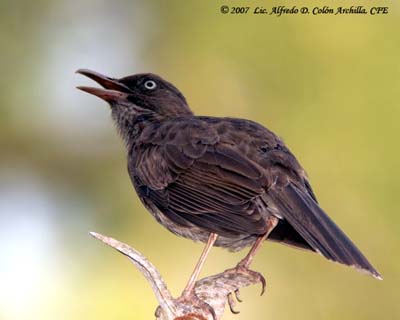
HABITAT:
Pearly-eyed Thrasher frequents varied types of habitats such as dense shrubs and thickets, wooded areas and forests, plantations, abandoned cultivated areas and orchards, and even urban areas. At sea level, it frequents palm and mangrove forests.
In Puerto Rico, it occurs at all elevations. It is common above 250 metres in wet forests on Dominica. On Bonaire, the species is restricted to fruit plantations in dry season, but it is widespread after rains.
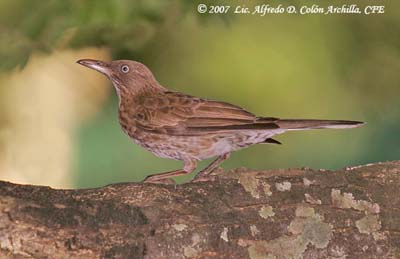
RANGE:
Pearly-eyed Thrasher is resident in its range. It is found in Puerto Rico, the Virgin Islands, the Bahamas and Antilles.
BEHAVIOUR:
Pearly-eyed Thrasher is omnivorous, feeding on insects, berries, fruits and small vertebrates. This bird is a predator for eggs and nestlings of several other birds’ species such as Columbidae, Psittacidae and other Mimidae.
It also catches lizards, tree-frogs and land-crabs.
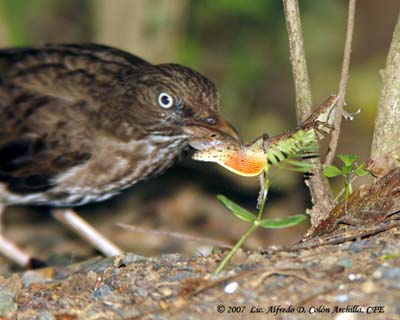
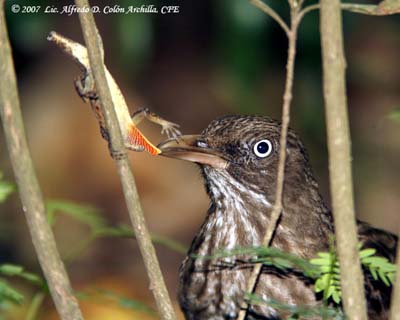
It may be aggressive and it is classified as an opportunistic species.
It feeds in groups, often seen in trees as arboreal forager species, from ground level up to five metres or more.
Pearly-eyed Thrasher is an aggressive bird. It attacks the nests for eggs and chicks.
In Puerto Rico, it is an important threat for rare birds. It is an important nest predator of the Puerto Rican Parrot. It enters the hole and breaks or destroys the eggs.
They are sometimes killed when they attempt to enter some protected and guarded nests.
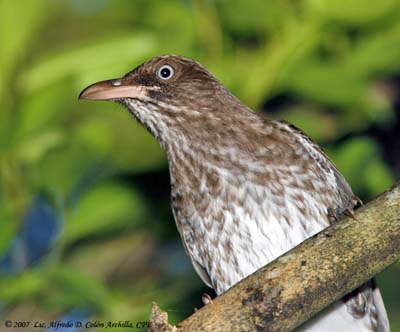
Thrashers are territorial birds, using songs, aerial displays and tail and wing displays for chasing intruders. This one kills some birds and destroys the nests of potential predators, and also steals nest materials.
Pearly-eyed Thrasher is resident in its range, with some wandering outside the breeding areas.
FLIGHT:
Pearly-eyed Thrasher is an arboreal species, rarely seen long time on the ground. Locomotion over short distance is often achieved by running rather than flying. Access to nests and high perches are gained by climbing and not by flight.
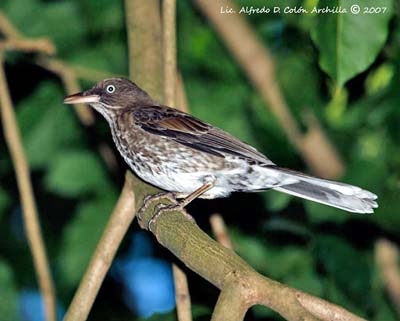
REPRODUCTION:
Breeding season varies according to the range.
Pearly-eyed Thrasher is a cavity nester. The nest is bulky, made with twigs, dry grasses and roots. It is placed in cavity or even in nest-box, buildings, porches and caves. It may sometimes be placed in open, in tree or bush, but rarely.
Female lays 2-3 glossy blue-green eggs. Incubation lasts two weeks. The nesting period lasts 19-21 days.
This species produces several broods during the extended breeding season.
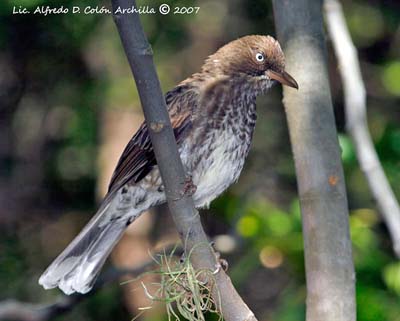
DIET:
Pearly-eyed Thrasher feeds on large insects, numerous kinds of fruits and berries, eggs and nestlings of several birds’ species, carrion and small rodents.
This bird may store food items impaled on thorns as shrikes, or jammed into a fork in bush. It also catches lizards on some islands.
